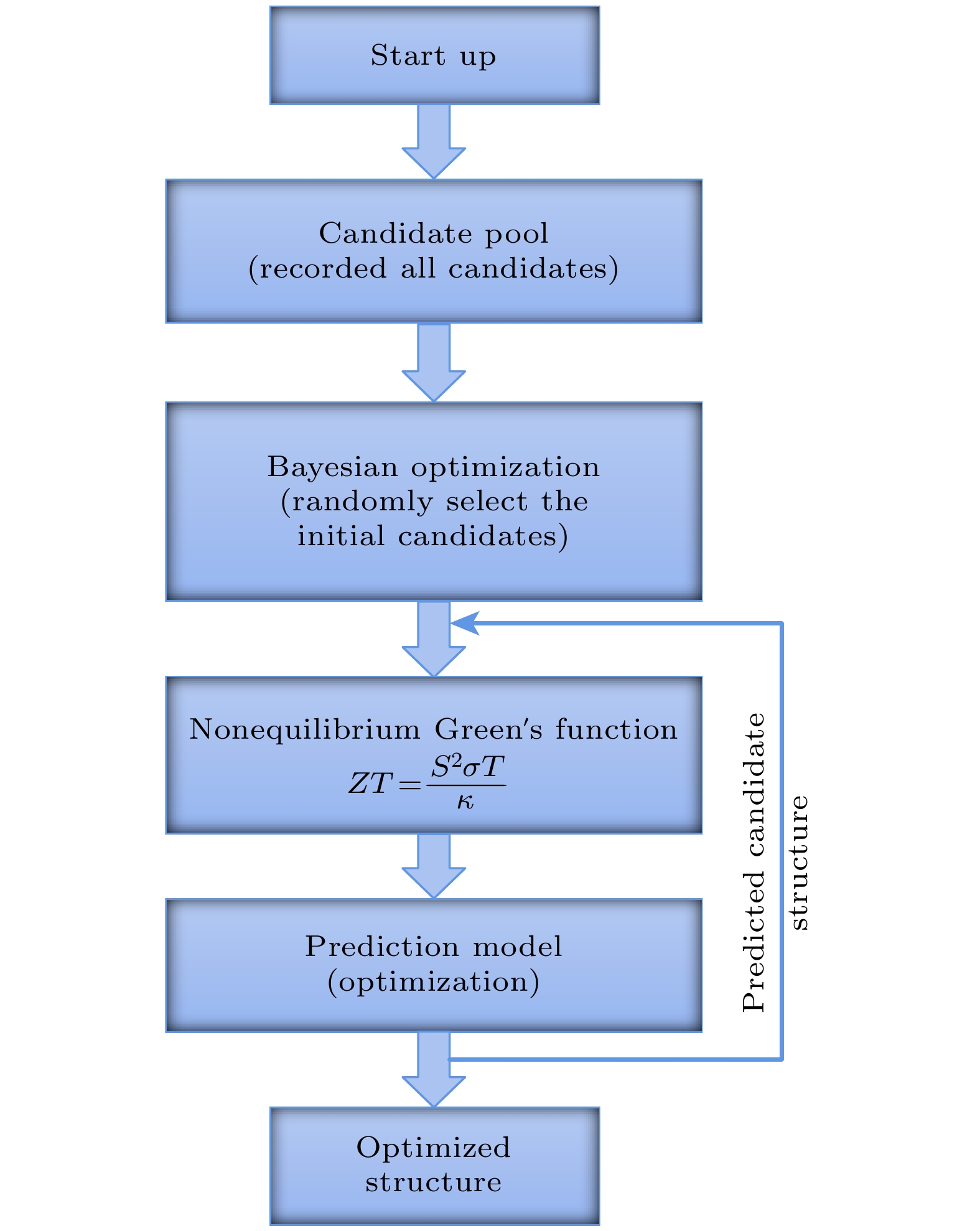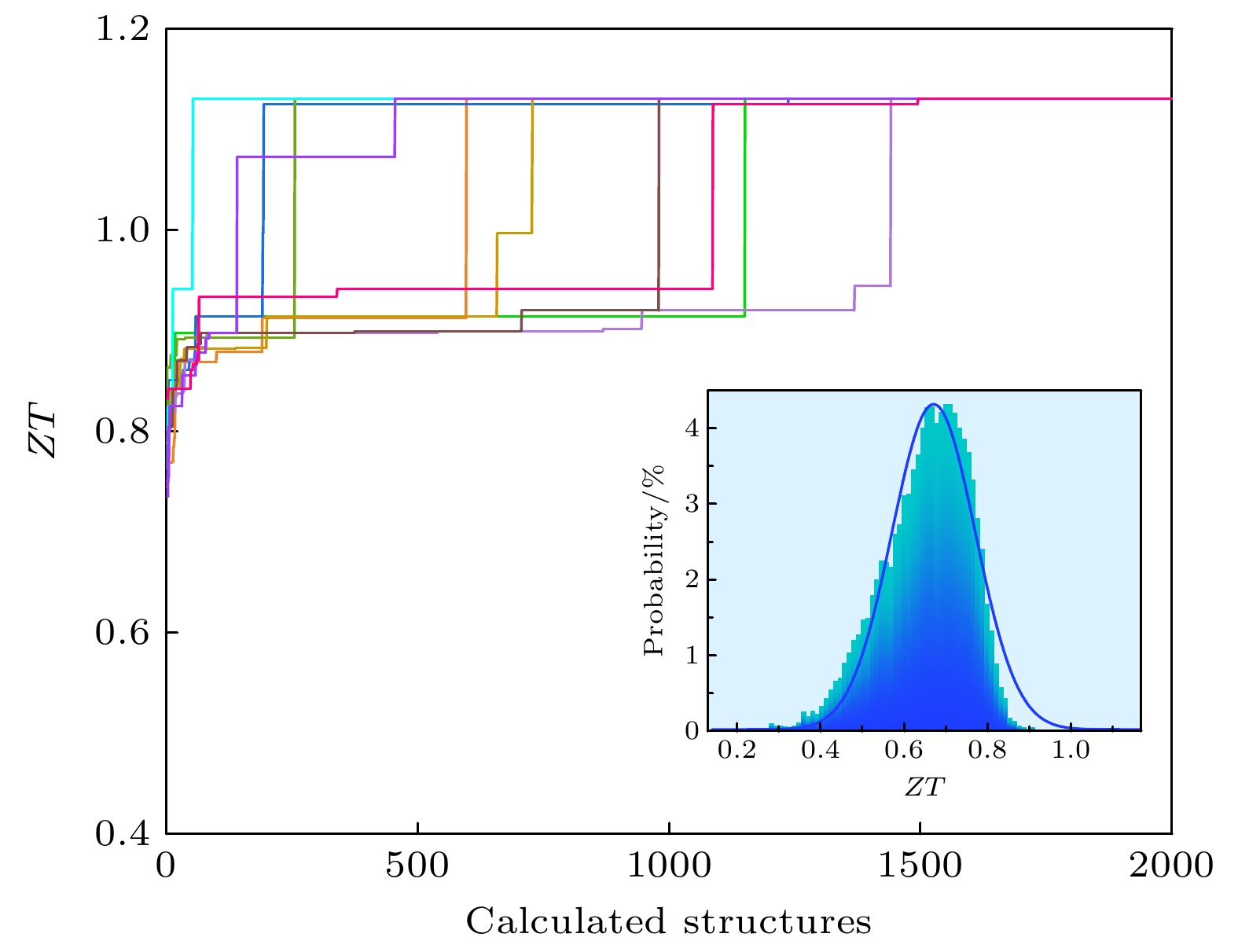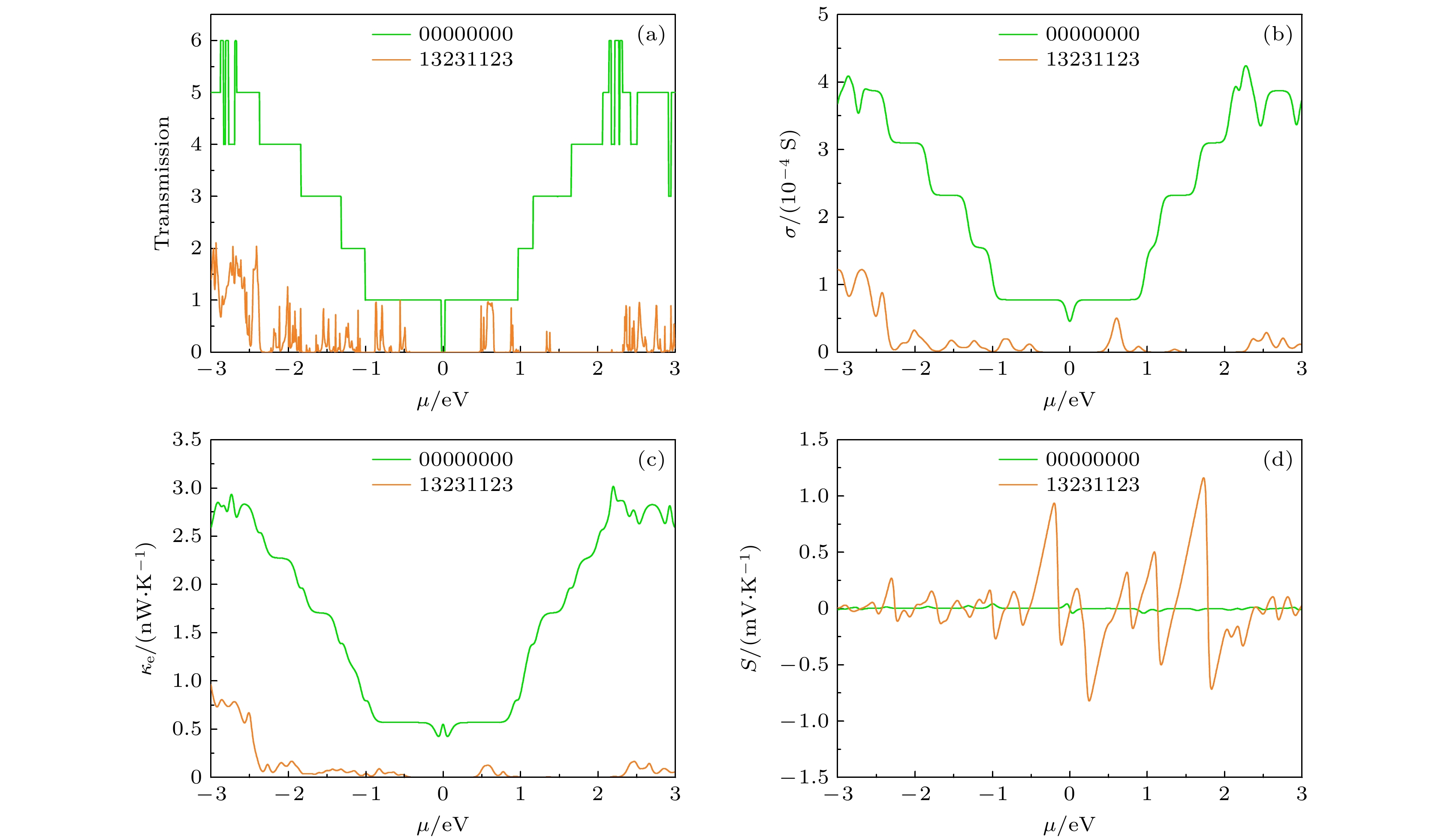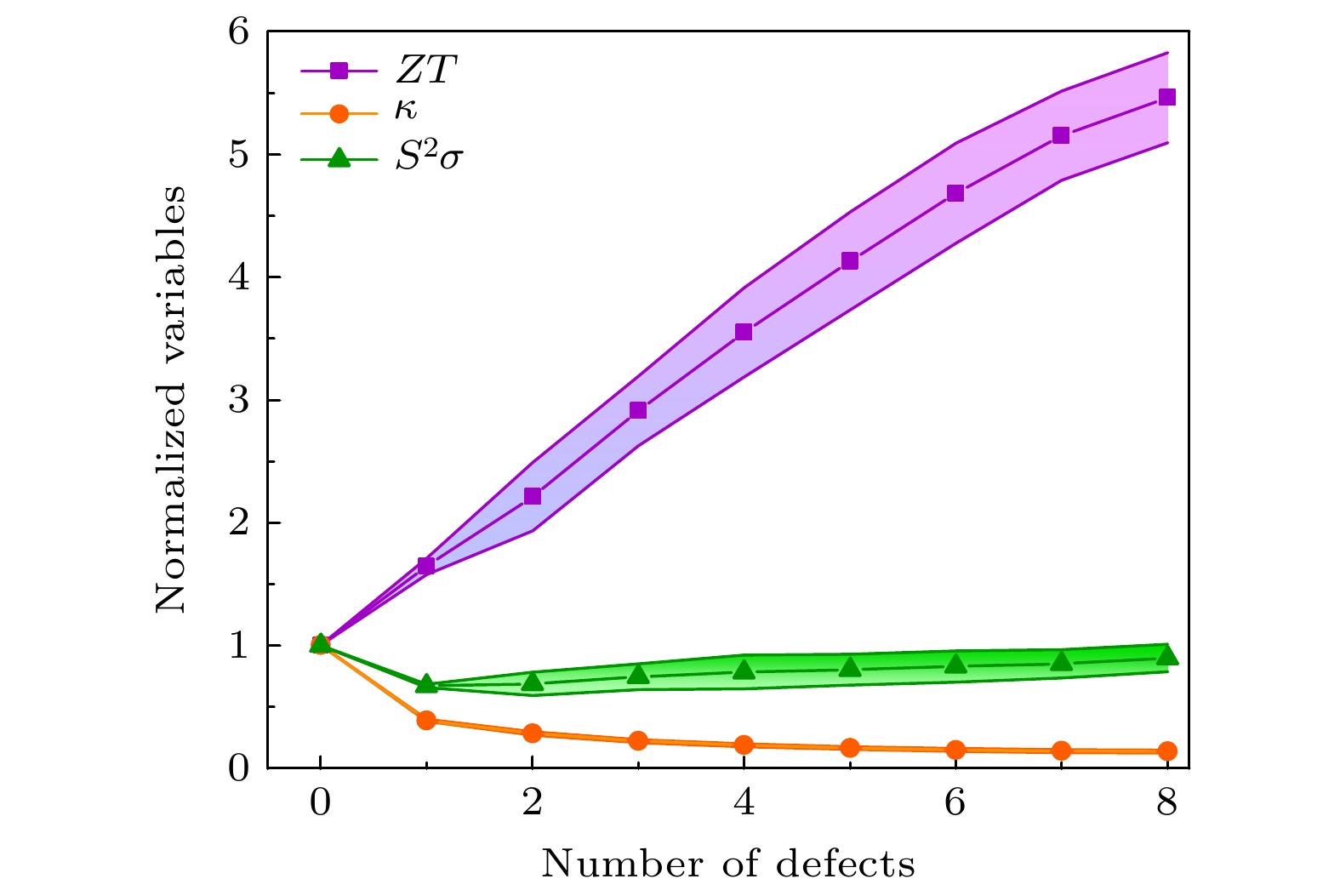-
由于结构巨大的自由度, 缺陷石墨烯纳米带热电转换性能的优化设计是材料研究领域的难点之一. 本文利用非平衡格林函数结合贝叶斯算法, 对5-7环缺陷石墨烯纳米带热电性能进行了优化设计. 研究结果表明, 在搜寻具有高热电转换效率5-7环缺陷石墨烯纳米带的过程中, 贝叶斯算法具备有效性和优越性. 计算发现, 利用贝叶斯算法能快速且准确地从32896个候选结构中搜索到具有最佳热电转换性能的唯一构型. 即使在效率最低的一轮优化中, 也仅需要计算1495个候选结构(约占所有候选结构的4.54%)即可寻找到最佳构型. 研究还发现, 在室温下的最佳构型5-7环缺陷石墨烯纳米带(长和宽分别为21.162 nm和1.23 nm)的热电优值ZT (约1.13)较完美石墨烯纳米带(约0.14)提升了近一个量级. 这主要归因于5-7环缺陷有效抑制了系统的电子热导率, 使得功率因子的减弱作用和热导率的抑制作用(正效应)之间达到了最大平衡. 研究结果为设计和制备具有优异热电转换效率的石墨烯纳米带热电器件提供了一种新的可行性方案.
-
关键词:
- 热电转换 /
- 5-7环缺陷石墨烯纳米带 /
- 贝叶斯算法 /
- 非平衡格林函数
Owing to the huge degree of freedom of structure, the optimal design of thermoelectric conversion performance of defective graphene nanoribbons is one of the difficulties in the field of materials research. In this paper, the thermoelectric properties of graphene nanoribbons with 5-7 ring defects are optimized by using non-equilibrium Green's function combined with Bayesian algorithm.The results show that the Bayesian algorithm is effective and advantageous in the search of graphene nanoribbons with 5-7 ring defects with high thermoelectric conversion efficiency. It is found that the single configuration with the best thermoelectric conversion performance can be quickly and accurately searched from 32896 candidate structures by using Bayesian algorithm. Even in the least efficient round of optimization, only 1495 candidate structures (about 4.54% of all candidate structures) need to be calculated to find the best configuration. It is also found that the thermoelectric value ZT (about 1.13) of the optimal configuration of 5-7 ring defective graphene nanoribbons (21.162 and 1.23 nm in length and width, respectively) at room temperature is nearly one order of magnitude higher than that of the perfect graphene nanoribbons (about 0.14). This is mainly due to the fact that the 5-7 ring defects effectively inhibit the electron thermal conductivity of the system, which makes the maximum balance between the weakening effect of the power factor and the inhibiting effect of the thermal conductivity (positive effect). The results of this study provide a new feasible scheme for designing and fabricating the graphene nanoribbon thermoelectric devices with excellent thermoelectric conversion efficiencies.-
Keywords:
- thermoelectric conversion /
- 5-7 ring defective graphene nanoribbons /
- Bayes algorithm /
- nonequilibrium Green's function
[1] Zhu T, Liu Y, Fu C, Heremans J P, Snyder J G, Zhao X 2017 Adv. Mater. 29 1605884
 Google Scholar
Google Scholar
[2] Tritt T M 2011 Annu. Rev. Mater. Res. 41 433
 Google Scholar
Google Scholar
[3] Zhang X, Zhao L D 2015 J. Materiomics 1 92
 Google Scholar
Google Scholar
[4] Parrott J E 1982 J. Appl. Phys. 53 9105
 Google Scholar
Google Scholar
[5] Zheng X F, Liu C X, Yan Y Y, Wang Q 2014 Renewable Sustainable Energy Rev. 32 486
 Google Scholar
Google Scholar
[6] Wang X, Xu J, Liu G, Fu Y, Liu Z, Tan X, Shao H, Jiang H, Tan T, Jiang J 2016 Appl. Phys. Lett. 108 083902
 Google Scholar
Google Scholar
[7] Yang J, Xi L, Qiu W, Wu L, Shi X, Chen L, Yang J, Zhang W, Uher C, Singh D J 2016 NPJ. Comput. Mater. 2 1
 Google Scholar
Google Scholar
[8] Kim W, Zide J, Gossard A, Klenov D, Stemmer S, Shakouri A, Majumdar A 2006 Phys. Rev. Lett. 96 045901
 Google Scholar
Google Scholar
[9] Wan X, Ma D, Pan D, Yang L, Yang N 2021 Mater. Today Phys. 20 100445
 Google Scholar
Google Scholar
[10] Miyata K, Atallah T L, Zhu X-Y 2017 Sci. Adv. 3 e1701469
 Google Scholar
Google Scholar
[11] Sales B, Mandrus D, Chakoumakos B C, Keppens V, Thompson J R 1997 Phys. Rev. B 56 15081
 Google Scholar
Google Scholar
[12] Jaworski C M, Nielsen M D, Wang H, Girard S N, Cai W, Porter W D, Kanatzidis M G, Heremans J P 2013 Phys. Rev. B 87 045203
 Google Scholar
Google Scholar
[13] Pei Y, Heinz N A, LaLonde A, Snyder G J 2011 Energy Environ. Sci. 4 3640
 Google Scholar
Google Scholar
[14] Xie G, Ding D, Zhang G 2018 Adv. Phys. X 3 1480417
 Google Scholar
Google Scholar
[15] Ouyang T, Hu M 2014 Nanotechnology 25 245401
 Google Scholar
Google Scholar
[16] Wang T, Zhang C, Snoussi H, Zhang G 2020 Adv. Funct. Mater. 30 1906041
 Google Scholar
Google Scholar
[17] Wang J, Jiang J W, Park H S 2020 Carbon 157 262
 Google Scholar
Google Scholar
[18] Wan X, Feng W, Wang Y, Wang H, Zhang X, Deng C, Yang N 2019 Nano Lett. 19 3387
 Google Scholar
Google Scholar
[19] Yang L, Wan X, Ma D, Jiang Y, Yang N 2021 Phys. Rev. B 103 155305
 Google Scholar
Google Scholar
[20] Ju S, Shiga T, Feng L, Hou Z, Tsuda K, Shiomi J 2017 Phys. Rev. X 7 021024
 Google Scholar
Google Scholar
[21] Hu R, Iwamoto S, Feng L, Ju S, Hu S, Ohnishi M, Nagai N, Hirakawa K, Shiomi J 2020 Phys. Rev. X 10 021050
 Google Scholar
Google Scholar
[22] Yamawaki M, Ohnishi M, Ju S, Shiomi J 2018 Sci. Adv. 4 eaar4192
 Google Scholar
Google Scholar
[23] Dieb M T, Hou Z, Tsuda K 2018 J. Chem. Phys. 148 241716
 Google Scholar
Google Scholar
[24] Lu S, Zhou Q, Ouyang Y, Guo Y, Li Q, Wang J 2018 Nat. Commun. 9 3405
 Google Scholar
Google Scholar
[25] Yuan R, Liu Z, Balachandran P V, Xue D, Zhou Y, Ding X, Sun J, Xue D, Lookman T 2018 Adv. Mater. 30 1702884
 Google Scholar
Google Scholar
[26] Ju S, Shimizu S, Shiomi J 2020 J. Appl. Phys. 128 161102
 Google Scholar
Google Scholar
[27] Cui C, Ouyang T, Tang C, He C, Li J, Zhang C, Zhong J 2021 Carbon 176 52
 Google Scholar
Google Scholar
[28] Hu J, Ruan X, Chen Y P 2009 Nano Lett. 9 2730
 Google Scholar
Google Scholar
[29] Balandin A A 2011 Nat. Mater. 10 569
 Google Scholar
Google Scholar
[30] 潘东楷, 宗志成, 杨诺 2022 物理学报 71 086302
 Google Scholar
Google Scholar
Pan D K, Zong Z C, Yang N 2022 Acta Phys. Sin. 71 086302
 Google Scholar
Google Scholar
[31] Seol J H, Jo I, Moore A L, Lindsay L, Aitken Z H, Pettes M T, Li X, Yao Z, Huang R, Broido D, Mingo N, Ruoff R S, Shi L 2010 Science 328 213
 Google Scholar
Google Scholar
[32] Balandin A A, Ghosh S, Bao W, Calizo I, Teweldebrhan D, Miao F, Lau C N 2008 Nano Lett. 8 902
 Google Scholar
Google Scholar
[33] Sevinçli H, Cuniberti G 2010 Phys. Rev. B 81 113401
 Google Scholar
Google Scholar
[34] Yang K, Chen Y, Xie Y, Ouyang T, Zhong J 2010 EPL-Europhys. Lett. 91 46006
 Google Scholar
Google Scholar
[35] Sevincli H, Sevik C, Çağın T, Cuniberti G 2013 Sci. Rep. 3 1228
 Google Scholar
Google Scholar
[36] Chen Y, Jayasekera T, Calzolari A, Kim K W, Nardelli M B 2010 J. Phys. Condens. Mater 22 372202
 Google Scholar
Google Scholar
[37] Mazzamuto F, Nguyen V H, Apertet Y, Caër C, Chassat C, Saint-Martin J, Dollfus P 2011 Phys. Rev. B 83 235426
 Google Scholar
Google Scholar
[38] Ouyang Y, Guo J 2009 Appl. Phys. Lett. 94 263107
 Google Scholar
Google Scholar
[39] Karamitaheri H, Neophytou N, Pourfath M, Faez R, Kosina H 2012 J. Appl. Phys. 111 054501
 Google Scholar
Google Scholar
[40] Huang J Y, Ding F, Yakobson B I, Lu P, Qi L, Li J 2009 Proc. Natl. Acad. Sci. 106 10103
 Google Scholar
Google Scholar
[41] Engelund M, Fürst J A, Jauho A P, Brandbyge M 2010 Phys. Rev. Lett. 104 036807
 Google Scholar
Google Scholar
[42] Cresti A, Carrete J, Okuno H, Wang T, Madsen G K, Mingo N, Pochet P 2020 Carbon 161 259
 Google Scholar
Google Scholar
[43] Wang J S, Wang J, Lü J T 2008 Eur. Phys. J. B 62 381
 Google Scholar
Google Scholar
[44] Yamamoto T, Watanabe K 2006 Phys. Rev. Lett. 96 255503
 Google Scholar
Google Scholar
[45] Li T C, Lu S P 2008 Phys. Rev. B 77 085408
 Google Scholar
Google Scholar
[46] Yang K, Chen Y, D'Agosta R, Xie Y, Zhong J, Rubio A 2012 Phys. Rev. B 86 045425
 Google Scholar
Google Scholar
[47] Ueno T, Rhone T D, Hou Z, Mizoguchi T, Tsuda K 2016 Mater. Discovery 4 18
 Google Scholar
Google Scholar
[48] Terayama K, Tsuda K, Tamura R 2019 Jpn. J. Appl. Phys. 58 098001
 Google Scholar
Google Scholar
[49] Franckié M, Faist J 2020 Phys. Rev. Appl. 13 034025
 Google Scholar
Google Scholar
-
图 1 四进制标志作为结构描述符 (a) “0”代表完美单元; (b) “1”代表5-7环缺陷位置在中间(黄色标注)的缺陷单元; (c) “2”代表5-7环缺陷位置在左边(紫色标注)的缺陷单元; (d) “3”代表5-7环缺陷位置在右边(蓝色标注)的缺陷单元
Fig. 1. Quad symbol as structural descriptor: (a) ‘0’represents perfect unit; (b) ‘1’ represents the defect unit with 5-7 ring defects in the middle (marked in yellow); (c) ‘2’ represents the defect unit with the defect position on the left of the 5-7 ring (marked in purple); (d)‘3’ represents the defect unit of rings 5-7 where the defect position is on the right (marked in blue).
图 6 完美石墨烯纳米带和最佳5-7环缺陷石墨烯纳米带的电子性质 (a) 电子透射系数; (b) 电子电导; (c) 电子热导; (d) 塞贝克系数
Fig. 6. Electronic properties of perfect graphene nanoribbons and best 5-7 ring defective graphene nanoribbons: (a) Electron transmission coefficient; (b) electronic conductivity; (c) electron thermal conductivity; (d) Seebeck coefficient.
图 7 比较原始石墨烯纳米带和最佳5-7环缺陷石墨烯纳米带的声子输运特性 (a) 声子热导; (b) 声子透射系数; (c), (d) 三个典型声子频率下的声子局域态密度图
Fig. 7. Phonon transport characteristics of the original graphene nanoribbon and the best 5-7 ring defect graphene nanoribbon are compared: (a) Phonon thermal conductivity; (b) phonon transmission coefficient; (c), (d) local state density diagram at three typical phonon frequencies.
-
[1] Zhu T, Liu Y, Fu C, Heremans J P, Snyder J G, Zhao X 2017 Adv. Mater. 29 1605884
 Google Scholar
Google Scholar
[2] Tritt T M 2011 Annu. Rev. Mater. Res. 41 433
 Google Scholar
Google Scholar
[3] Zhang X, Zhao L D 2015 J. Materiomics 1 92
 Google Scholar
Google Scholar
[4] Parrott J E 1982 J. Appl. Phys. 53 9105
 Google Scholar
Google Scholar
[5] Zheng X F, Liu C X, Yan Y Y, Wang Q 2014 Renewable Sustainable Energy Rev. 32 486
 Google Scholar
Google Scholar
[6] Wang X, Xu J, Liu G, Fu Y, Liu Z, Tan X, Shao H, Jiang H, Tan T, Jiang J 2016 Appl. Phys. Lett. 108 083902
 Google Scholar
Google Scholar
[7] Yang J, Xi L, Qiu W, Wu L, Shi X, Chen L, Yang J, Zhang W, Uher C, Singh D J 2016 NPJ. Comput. Mater. 2 1
 Google Scholar
Google Scholar
[8] Kim W, Zide J, Gossard A, Klenov D, Stemmer S, Shakouri A, Majumdar A 2006 Phys. Rev. Lett. 96 045901
 Google Scholar
Google Scholar
[9] Wan X, Ma D, Pan D, Yang L, Yang N 2021 Mater. Today Phys. 20 100445
 Google Scholar
Google Scholar
[10] Miyata K, Atallah T L, Zhu X-Y 2017 Sci. Adv. 3 e1701469
 Google Scholar
Google Scholar
[11] Sales B, Mandrus D, Chakoumakos B C, Keppens V, Thompson J R 1997 Phys. Rev. B 56 15081
 Google Scholar
Google Scholar
[12] Jaworski C M, Nielsen M D, Wang H, Girard S N, Cai W, Porter W D, Kanatzidis M G, Heremans J P 2013 Phys. Rev. B 87 045203
 Google Scholar
Google Scholar
[13] Pei Y, Heinz N A, LaLonde A, Snyder G J 2011 Energy Environ. Sci. 4 3640
 Google Scholar
Google Scholar
[14] Xie G, Ding D, Zhang G 2018 Adv. Phys. X 3 1480417
 Google Scholar
Google Scholar
[15] Ouyang T, Hu M 2014 Nanotechnology 25 245401
 Google Scholar
Google Scholar
[16] Wang T, Zhang C, Snoussi H, Zhang G 2020 Adv. Funct. Mater. 30 1906041
 Google Scholar
Google Scholar
[17] Wang J, Jiang J W, Park H S 2020 Carbon 157 262
 Google Scholar
Google Scholar
[18] Wan X, Feng W, Wang Y, Wang H, Zhang X, Deng C, Yang N 2019 Nano Lett. 19 3387
 Google Scholar
Google Scholar
[19] Yang L, Wan X, Ma D, Jiang Y, Yang N 2021 Phys. Rev. B 103 155305
 Google Scholar
Google Scholar
[20] Ju S, Shiga T, Feng L, Hou Z, Tsuda K, Shiomi J 2017 Phys. Rev. X 7 021024
 Google Scholar
Google Scholar
[21] Hu R, Iwamoto S, Feng L, Ju S, Hu S, Ohnishi M, Nagai N, Hirakawa K, Shiomi J 2020 Phys. Rev. X 10 021050
 Google Scholar
Google Scholar
[22] Yamawaki M, Ohnishi M, Ju S, Shiomi J 2018 Sci. Adv. 4 eaar4192
 Google Scholar
Google Scholar
[23] Dieb M T, Hou Z, Tsuda K 2018 J. Chem. Phys. 148 241716
 Google Scholar
Google Scholar
[24] Lu S, Zhou Q, Ouyang Y, Guo Y, Li Q, Wang J 2018 Nat. Commun. 9 3405
 Google Scholar
Google Scholar
[25] Yuan R, Liu Z, Balachandran P V, Xue D, Zhou Y, Ding X, Sun J, Xue D, Lookman T 2018 Adv. Mater. 30 1702884
 Google Scholar
Google Scholar
[26] Ju S, Shimizu S, Shiomi J 2020 J. Appl. Phys. 128 161102
 Google Scholar
Google Scholar
[27] Cui C, Ouyang T, Tang C, He C, Li J, Zhang C, Zhong J 2021 Carbon 176 52
 Google Scholar
Google Scholar
[28] Hu J, Ruan X, Chen Y P 2009 Nano Lett. 9 2730
 Google Scholar
Google Scholar
[29] Balandin A A 2011 Nat. Mater. 10 569
 Google Scholar
Google Scholar
[30] 潘东楷, 宗志成, 杨诺 2022 物理学报 71 086302
 Google Scholar
Google Scholar
Pan D K, Zong Z C, Yang N 2022 Acta Phys. Sin. 71 086302
 Google Scholar
Google Scholar
[31] Seol J H, Jo I, Moore A L, Lindsay L, Aitken Z H, Pettes M T, Li X, Yao Z, Huang R, Broido D, Mingo N, Ruoff R S, Shi L 2010 Science 328 213
 Google Scholar
Google Scholar
[32] Balandin A A, Ghosh S, Bao W, Calizo I, Teweldebrhan D, Miao F, Lau C N 2008 Nano Lett. 8 902
 Google Scholar
Google Scholar
[33] Sevinçli H, Cuniberti G 2010 Phys. Rev. B 81 113401
 Google Scholar
Google Scholar
[34] Yang K, Chen Y, Xie Y, Ouyang T, Zhong J 2010 EPL-Europhys. Lett. 91 46006
 Google Scholar
Google Scholar
[35] Sevincli H, Sevik C, Çağın T, Cuniberti G 2013 Sci. Rep. 3 1228
 Google Scholar
Google Scholar
[36] Chen Y, Jayasekera T, Calzolari A, Kim K W, Nardelli M B 2010 J. Phys. Condens. Mater 22 372202
 Google Scholar
Google Scholar
[37] Mazzamuto F, Nguyen V H, Apertet Y, Caër C, Chassat C, Saint-Martin J, Dollfus P 2011 Phys. Rev. B 83 235426
 Google Scholar
Google Scholar
[38] Ouyang Y, Guo J 2009 Appl. Phys. Lett. 94 263107
 Google Scholar
Google Scholar
[39] Karamitaheri H, Neophytou N, Pourfath M, Faez R, Kosina H 2012 J. Appl. Phys. 111 054501
 Google Scholar
Google Scholar
[40] Huang J Y, Ding F, Yakobson B I, Lu P, Qi L, Li J 2009 Proc. Natl. Acad. Sci. 106 10103
 Google Scholar
Google Scholar
[41] Engelund M, Fürst J A, Jauho A P, Brandbyge M 2010 Phys. Rev. Lett. 104 036807
 Google Scholar
Google Scholar
[42] Cresti A, Carrete J, Okuno H, Wang T, Madsen G K, Mingo N, Pochet P 2020 Carbon 161 259
 Google Scholar
Google Scholar
[43] Wang J S, Wang J, Lü J T 2008 Eur. Phys. J. B 62 381
 Google Scholar
Google Scholar
[44] Yamamoto T, Watanabe K 2006 Phys. Rev. Lett. 96 255503
 Google Scholar
Google Scholar
[45] Li T C, Lu S P 2008 Phys. Rev. B 77 085408
 Google Scholar
Google Scholar
[46] Yang K, Chen Y, D'Agosta R, Xie Y, Zhong J, Rubio A 2012 Phys. Rev. B 86 045425
 Google Scholar
Google Scholar
[47] Ueno T, Rhone T D, Hou Z, Mizoguchi T, Tsuda K 2016 Mater. Discovery 4 18
 Google Scholar
Google Scholar
[48] Terayama K, Tsuda K, Tamura R 2019 Jpn. J. Appl. Phys. 58 098001
 Google Scholar
Google Scholar
[49] Franckié M, Faist J 2020 Phys. Rev. Appl. 13 034025
 Google Scholar
Google Scholar
计量
- 文章访问数: 7014
- PDF下载量: 110
- 被引次数: 0














 下载:
下载:







